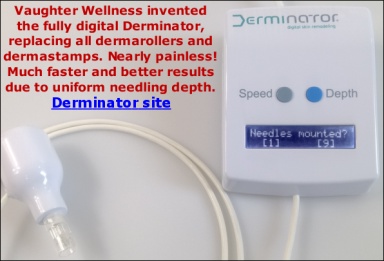Hi Rollin,
It's indeed correct that you should wait at least three weeks in between rolling the same skin with a 1.5 mm dermaroller.
It is normal that stretchmarks or scars first look worse before they look better. All kinds of processes happen in the skin, after rolling. Discoloration, peeling, swelling, creation of new skin cells, increased blood flow, mild inflammatory reaction etc. I can reassure you that unless you have a very rare genetic skin disorder (easy scarring),
your marks will look better or at least the same after about ten days to two weeks. So don't despair. Wait four weeks now, and let us know here how the look of your marks is improving in the meantime. A 1.5 mm roller is a powerful, but "invasive" medical instrument and therefore, plastic surgeons warn people not to use it for home-rolling, exactly because there is so much conflicting advice on the Internet on how often one should roll, how one should roll, what creams to use etc.
So by all means use a 1.5 mm roller, but use it wisely.. It takes a lot of patience due to the requirement of only-once-a-month but it gets at the skin layers that need to be stimulated and therefore it really works. Those thousands of pricks first need to heal, then new collagen and elastin needs to grow, and when everything is 100% healed and regenerated, you can start the process again. In between, you can roll with a 0.2 mm roller, to enhance skincare products penetration. The months will finally have passed and you will see great results, but expect to wait ten months to be able to say: "Wow - do you see the difference with the photo ten months ago!". Of course we have a commercial enterprise, but we're not looking to get rich. No hype from us, no quick results, no dozens of fake testimonials either. Our advice is based on digging through medical literature (we will post links on this forum to all kinds of publications soon, however be advised that it is tedious stuff).
About the cream: I of course advise to use our ointment. An ointment is oil-based and occludes the skin after rolling (occlusion means preventing oxygen - a potent oxidant - from entering and preventing moisture - that keeps the cells alive - from escaping). This is very important, after rolling. Apart from being occlusive, our ointment contains a good form of vit. A for dermarolling aftercare. Not the too acidic Retinoic Acid, but Retinol Acetate. That makes our ointment suitable for use against first degree burns. Open skin should not be exposed to acids - as we know, acids etch away living tissue!
Our ointment also contains vit. D2, important for collagen and elastin production. Hunting for the right ointment was not easy because many contain unwanted ingredients such as Zinc (Zinc dehydrates the "open" skin too much). We only found the ointment we were looking for in the Czech Republic of all places.. Interesting, innovative country by the way - they used to be the most liberal and most hi-tech member of the countries behind the Iron Curtain. They do sell abroad, the actual ointment is quite cheap but they charge around 18 Euro to ship it. That's more than 25 USD. We buy 500 at a time to keep our retail price low, and we ship for much less. You won't need lots of the ointment because it is not absorbed by the skin - so you only need a very thin film. It's very soothing and does not cause irritation, it prevents the skin from drying out and peeling. Ointments, compared to creams, are a bit sticky and take some wiping to remove, but if you want to be beautiful, you have to suffer

Yes, we send worldwide and we sell our ointment ("Infadolan") separately here:
https://http://shop.owndoc.com/p-177/infadolan.html





